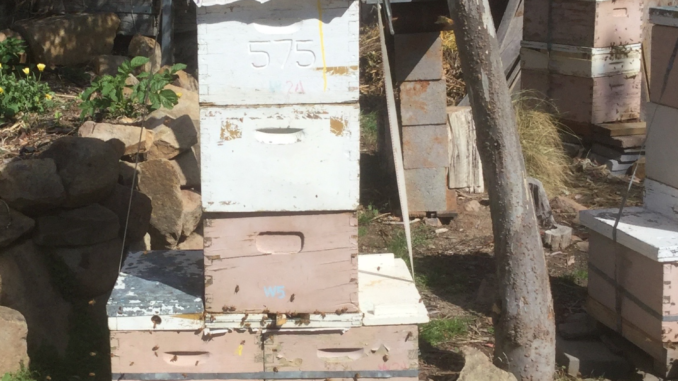
Frank Derwent and Alan Wade
Wild about hives
If you were seeking an impartial arbiter of the best designed house for a honey bee colony, you might go no further than to examine the architecture of wild hives, those built into cavities such as tree hollows. Tom Seeley and Roger Morse did just thati: They dissected the nests of twenty one hives taking measurements to define the essential characteristics of honey bee nests, sketching a preferred hive structure (Figure 1).
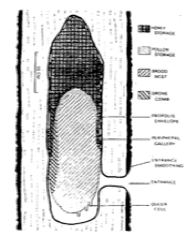
Figure 1: Nest structure for cold climate region, Icitha New York.
They found that colonies have a general preference for a nest deep inside the tree cavity, those with a small (32-89 mm2) bottom entrance and a nest cavity size between 30 and 60 L with a median capacity of 42 L.
Only honey bees (of the sub-genus Apis) build multi-comb nests and then usually, but not always, inside tree hollows or rock crevices: those built in the open normally fail to overwinter. This nesting strategy gives them a large measure of control of the internal hive environment, one that protects them from predators such as honey hunters, bears, rodents and wasps. Temperate races of the Western Honey Bee (Apis mellifera) and of the Asian Honey Bee (Apis cerana) amass stores of honey to tide them over long winters.
Wild about natural beekeeping
One of the objectives of natural beekeeping is to mimic the conditions of a successful wild hive. The most common examples available of this are the Kenyan Top Bar (KTB) hive with sloping sides, the rectangular section Tanzanian Top Bar hive and the Warré hive.
The hive commonly referred to as the Kenyan Top Bar hive was developed in 1971 by Maurice Smith and Gordon Townsend from the University of Guelph under a Kenyan project sponsored by the Canadian International Development Agency (CIDA). These and similar top bar hives replaced the traditional African log hives where the nest was often destroyed to harvest honey.
Needless to say the more efficient and more productive Langstroth hiveiii has replaced traditional hives almost everywhere, though top bar hives remain a favourite amongst amateurs.
A significant problem with all natural comb hive management systems is the need for comb destruction to harvest honey. This may be good for generating wax if that, and keeping bees for the sake of keeping them, are the key objectives of your keeping bees. However it is expensive in terms of honey production as it takes five kilograms of honey to produce an equivalent amount of wax. While frequent rendering of combs is a certain measure for reducing hive pathogen spore loads, experienced beekeepers regularly replace comb in the process of removing old and damaged combs. This limits the number of combs stored over winter subject to wax moth attack.
Highly nuanced arguments for running bees as naturally as possible have gained considerable kudos from Tom Seeley’s Darwinian Beekeepingiii. Well-practiced natural beekeeping reflects the real needs of bees, if not those of those of the avaricious beekeeper, such as the balance of drone numbers and worker bees in a colony and allowing bees to swarm freely, both important to survival strategies adopted by wild bees.
Top bar hives
Running top bar hives provides a close-to-natural window of observation of the wild hive, a feature not possible in the physically wood-armoured tree hollow. Of these the Kenyan and Tanzanian Top Bar Hives are the best known. KTB (Kenyan Top Bar) hive combs – though fragile – can be removed for inspection, their free-form construction closely replicating that of comb attached to the roof of wild hives.
If you have spare timber and good woodworking skills, you may be able to construct a KTB for a song. They are, however expensive to buyiv and critical clearances – read bee space – must be incorporated into their every design to avoid excessive gap filling by bees. In practice free-hanging combs take the same form as they do in a tree hollow where, however, cross-bracing is the norm. Control of this maze is one of the many skills required to operate KTBs well.
When built on stands, or with supporting legs, top bar hives can be comfortably inspected and are particularly popular amongst beekeepers with limited mobility. One saving grace of the KTB is that all frames are immediately accessible, that is without having to remove supers.
Employing standard full depth Langstroth frames, in in lieu of free-formed top bar combs, facilitates more robust frame handling while preserving the essential architecture of the top bar hive. Though less natural, Langstroth frames are far more robust and lend versatility to hive management as frames can be interchanged with those of any other hive
Despite the attractive features of KTBs, we argue that any system of keeping bees in a fully horizontal arrangement has a significant downside. In the wild, combs are attached to the roof, just as stalactites are in a limestone cave. This top-to-bottom, rather than side-to-side, mode of operation arises out of brood being raised on the lower comb perimeter and honey being stored in cells from which brood has emerged. Then, as the honey flow ends and as brood raising declines with approaching winter, the bees move upwards consuming honey and pollen to maintain hive homeostasis. In any wide-brood chamber setup, say a conventional twelve-frame full depth brood chamber, some honey is stored laterally. That honey is not warmed by bees and can’t form part of insulating honey mass above the winter cluster, a condition exacerbated in top bar hives.
Conventional tiered hives are more thermally efficient than KTBs for one simple reason. Heat rises rather than being advected horizontally and the hive cover area is relatively small. Möbus employed mini-anemometers to demonstrate that bees circulate air in an up-down pattern rather than horizontally. He argued that the narrow single bee space between honey combs restricts natural air movement – making honey, when located above brood, an efficient insulator – while the double bee space between brood combs facilitates both ready tending and warming of brood and crowding of bees in the winter cluster. In short the vertical arrangement conserves energy and facilitates more ready access of bees to stores.
That bees in horizontal hives often migrate towards stores to one end of the hive, leaving them unable to reach stores at the other end during winter, is further evidence that the horizontal arrangement is less than optimal. Émile Warré, in singing the design merits of his hive with built-in top-insulation, also emphasises the the importance of minimising the hive cover surface area and of having a thermal blanketing store of honey above the brood nest:
In winter, there is no risk of the bees getting cold, provided that the stores are above the cluster of bees.
Bees can thrive in horizontal setups, but one might take cognisance of Horr’sv experience with horizontal hives:
The long hive is no longer a bee hive, but may become a recycled planter box with a glass top for early spring or winter vegetables. I cannot say it did not work, the bees did fine but the beekeeper came up short of a crop. There is no way I know of to economically keep a horizontal three-hive body colony of bees…
In an even less complimentary tone an ANU researcher pal of ours noted wryly:
This KTB movement arose out of beekeepers reading grass roots magazines, keen to demonstrate that you can keep bees in any old wooden box or tea chest even if it does have moveable frames.
Another natural limiting feature of KTB hives is that their full capacity rarely exceeds that of an equivalent of two full depth eight-frame Langstroth supers – most KTB combs being considerably smaller than the standard full depth Langstroth comb. Nevertheless the skilled KTB operator, employing follower boards to optimise the space occupied by a colony of any given strength, replicates the standard practice of adding and removing supers.
From these observations you might assume that we are averse to keeping bees in horizontal hives? This is not the case. The horizontal expansion of hives is the only really practical alternative to tiering up supers. Indeed we have experimented widely with extremely large brood chambers especially those containing two laying queens with bee populations of up to 100,000 bees. There, as we shall see, a mix of horizontal and vertical architecture makes a horizontal element an attractive alternative to the skyscraper hivevi.
Why Warré?
Abbé Émile Warré (1867-1951) operated an apiary of 350 hives. He experimented widely inventing the People’s Hive [ruche populaire] or, as we now know it, the Warré Hive. Warré wanted to create a practical hive that would not only arrest a declining French beekeeping industry but also to replicate the features of wild beehives that would make built hives more productive. He published his findingsvii in L’Apiculture Pour Tous [Beekeeping for All] in 1948. Warré, despite his noble objectives, was not averse to the homily:
Furthermore, beekeeping is a moral activity, as far as it keeps one away from cafés and low places and puts before the beekeeper an example of work, order and devotion to the common cause.
Unlike the Langstroth hive, even better designed to maximise colony strength and maximise honey production and housing very robust frames, the Warré hive was designed to be a natural hive that was nevertheless productive. Warré hive covers are insulating and moisture regulating while their combs, though constrained to minimise wall comb attachment, are free-formed allowing a natural balance of worker and drone comb. Furthermore the overall capacity of two Warré supers (2×18.9 L) closely approximates that of the cavity size of wild hives (~42 L). For comparison an eight frame Langstroth super has a 42 L capacity.viii. Warré’s recommendation was to operate three storey hives (each with internal dimensions 210 mm deep and 300 x 300 mm wide and long), allowing for two brood chambers and a single honey super.
He advocated a minimal wall thickness of 20 mm – employed in the hives we have seen – though he did recommended 24 mm timber to improve hive body rigidity. In colder climates 38 and 50 mm thick timber has been employed to improve insulation.
To further replicate the natural hive condition, Warré hives are operated excluder-free, a minimalist scheme that many beekeepers claim avoids restricting queen laying potential. For the most part, brood is infrequently found in upper supers during a honey flow, though the use of excluders ensures that queens can be more readily found and are less likely to be lost when harvesting honey. However, and for these reasons, we find queen excluders helpful and use them except in winter where all bees need free and full access to stores.
So for the beekeeper intent on keeping bees for their own sake, the Warré has a wonderful attraction. Skilled Warré hive operators are keen bee observers and their practice of nadiring (under supering) colonies replicates the natural hive instinct. Because of their setup, Warré colonies can overwinter on more limited stores, and in a smaller cluster, than can bees in uninsulated Langstroth hives.
Do we have the same fatal attraction for the Warré hive? Probably not if only because we find that conventional hives are more readily managed. We prefer the Langstroth hive model over the Warré hive because we believe it better reflects the space requirements of the very productive bee queens now available, because frames of bees, stores and brood are much sturdier and less subject to cross bracing, and because frames of bees, stores and brood are more readily exchangeable with standard hive gear. Further Langstroth frames are readily extracted and returned to the hive and can be reused even when bees are not inclined to build comb.
Why Langstroth?
A key question remains: ‘In mimicking the naturally occurring hive, do we get a good hive design?’
So some wild hive design features, those shared by bees kept in skeps or that occupy a wall cavity, are entirely unsuited to contemporary hive management. More space is needed and combs that are moveable became essential hive design components. Following the post-skep era, typified by Alfred Neighbour’s The apiary: bees, bee-hives, and bee culture that we visited in our skep series, a multitude of new-fanged moveable frame designs emerged.
This all comes back to what ones beekeeping aims are. In their natural state bees swarm profligately to replace colonies lost to predation, disease and starvation, trading this strategy with building only sufficient stores to overwinter. Nature is harsh and swarmed bees but also parent colonies may not survive. This occurs more frequently when summer honey and pollen flows are poor and where winters are particularly severe.
Into this melee Langstroth stepped in.
Firstly Langstroth very clearly articulated the importance of very practical moveable frame hives for modern beekeeping practice. In advertising his patented 1852 Langstroth hiveix – he noted:
Each comb in this hive is attached to a separate, moveable frame, and in less than five minutes they may all be taken out, without cutting or injuring them, or at all enraging the bees… New colonies may be formed in less time than is usually required to hive a natural swarm; or the hive may be used as a non swarmer, or managed on the common swarming plan…
Secondly the standard Langstroth hive incorporated all the critical comb and space requirements that bees employ those featured in François Huber’sx early leaf hive and improved by Johann Dzierżońxi and Lorenzo Lorraine Langstrothxii.
The Langstroth hive has stood the test of time.
However some changes were needed and the modern Langstroth hive bears very little resemblance to the original hive design. Back then the Langstroth comprised a set of crates that carried the frames, the crates being inserted into a box-like outer cover. But the standard frame width was, and will aways be, 27 mm (1 1/16”) while most frames are 480 mm (19”) long.
The relative merits of eight, ten and twelve frame hives and their shallow, ideal, WS Pender and full depth supers – there are many variants internationally – will always be contentious. To these we can add the FlowTM hive, a 2015 Australian invention of Cedar and Stuart Anderson. The super in this hive uses special frames with partially formed honeycomb cells in the super. A tap on the outside of the hive splits the cells when it is turned on. The honey flows through channels and drains into containers. It is not a new hive, well in the sense that it is a Langstroth hive that has been adapted.
However, while the issues of frame design and bee spacing have been fully resolved, there is less consensus about actual hive width, the optimal number of equivalent full depth frames a hive body should hold.
From a bee perspective, and from an ease of handling perspective, 8-9 frame full-depth frame hives appear to be not only an optimal configuration, but also represent the equivalent normal maximum number of frames that a queen can sustainably lay out. So it would appear sensible not to employ nucleus sized hive bodies (e.g. six frame supers) for strong colonies with a queen in full lay or overly large brood chambers. Indeed Simpson has signalled that restricting the horizontal dimensions of the brood nest, i.e. artificially reducing space for the queen to lay, is an important factor in promoting swarmingxiii.
Overall the actual depth of hive bodies is less critical. However full depth brood chambers, where the brood frames are a single entity and not broken by a vertical space – it tends to be filled with drone comb – would appear advisable. Many beekeepers use full depth gear if only to facilitate practices such as brood box reversal and, where hives are operated employing a single brood-chamber, to rotate of combs out of the brood nest.
For ease of lifting and handling, many beekeepers employ shallower supers for honey storage: manual decapping of smaller frames is certainly much easier. An extreme example is the employment of mini-nucs for queen mating. These may be standalone units or incorporated into regular hive design (Figure 2). Such hives are not self-sustaining and must be topped up with nurse bees shaken off brood frames.
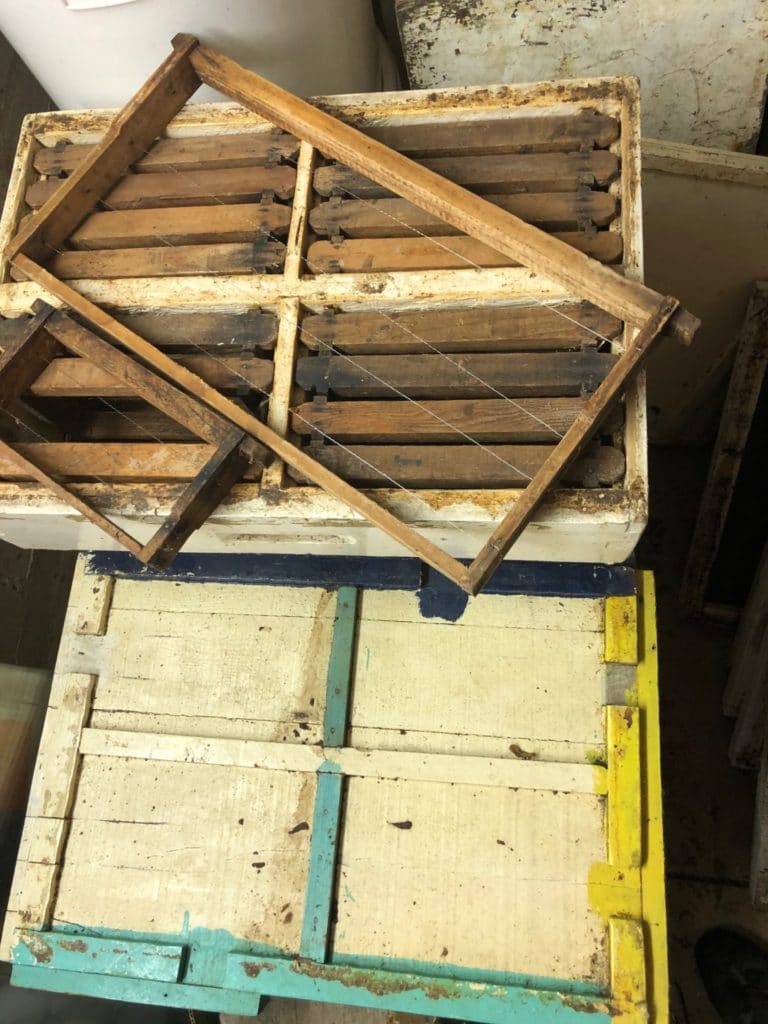
Figure 2 Mini mating nucs on a shallow multi-entrance floor board pattern. Photo: Alan Wade
Amongst Langstroth hive operators using all wooden gear, there have been two recent improvements in their overall design. One has been to fill out traditional vented migratory lids with insulation. We have employed R 1.1 value extruded 30 mm polystyrene sheeting gluing cut sections into the roof with filler adhesive silicon and sealing off the foam with 3 mm ply to prevent bees biting into the polystyrene (Figure 3), a scheme savvy top bar hive owners are similarly turning to. The other major advance has been to modify or replace solid bottom boards with screened boards, discussed below.

Figure 3 Simple retrofit insulation for standard Langstroth hive migratory lids. Photo: Alan Wade
The issue of insulating hives better segues into an unanswered question about the operation of Langstroth hives: What are the relative merits of horizontal and vertical hive modes of operation?
The horizontal vs vertical hive
Vertical beehives replicate the hollow tree advantage of rising brood nest warmth and the aforementioned annual cycle of colonies expanding downwards and contracting upwards. Tower systems are – for equivalent horizontal systems – far more productive and less problematic at least as far as the bees are concerned. Indeed the use of minimal sized boxes is inimical to the raison d’être of Warré hive design. This said any hive operating with more than 4-5 full depth supers suffers from some measure of physical instability.
So what are relative merits of horizontal and vertical hive setups, not just those emphasised by the problems of building multi-queened colonies. In principle, hives might be set up in the traditional vertical arrangement (Figure 4a) or in a ground-hugging orientation (Figure 4b).
For the vast majority of Langstroth hive operations, the vertical hive, limited to no more than three of four stories employing standard full-depth supers, or their equivalent of shallower supers, is a no brainer. But for exceptionally strong colonies, building in some horizontal element would appear to both practical and wise especially where standard honey supers (sometimes two or more per queen) are employed for honey storage. Unless hives can be abutted – as in double queen hives outlined in a recent Bee Buzz Box articles – the requirement for non-standard gear to operate horizontal Langstroth hive systems rules them out for widespread use.

(a) (b)
Figure 4 Vertical and horizontal hive modes of operation:
Note: the partition(s) dividing the supers may be a regular hive wall, a perforated or double screen or a queen excluder and there will be a separate hive entrance where there is a separate colony with a second queen.
Yet individual supers containing around twenty full depth Langstroth frames were of common occurrence through from about the 1880s through until the early 20th Century and have persisted amongst queen breeders in Australia – our famous Gretchen Wheen employed them for queen raising. Commercial beekeepers have found that, by inserting vertical queen excluders or solid division boards, they could start and finish queen cells in a single strong large hive body. Figure 5 emphasises the disparity between tower and horizontal hive architectures.
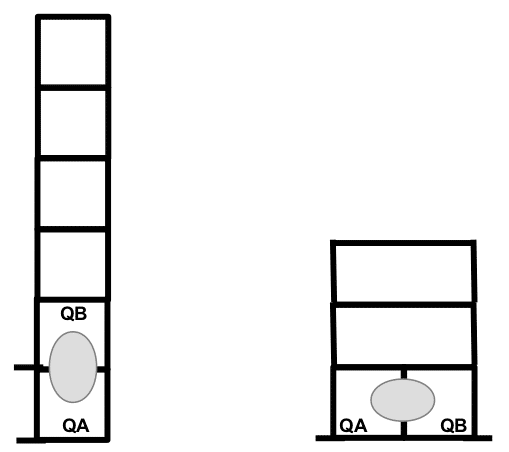
(a) (b)
Figure 5 Multi super hives – for two-queen operation – showing alternative hive orientations (a) likely more thermally efficient tower operation and (b) more physically stable scheme employing either large supers or doubled single supers at each level.
Note: Additional hive entrances can be employed during the main flow to facilitate direct return of nectar to honey supers.
In practice such monsters, either as towers or as compounded horizontal hives, have proved too cumbersome to move and are only suited to permanent apiary setups. We acquired a sixteen frame brood chamber hive body (Figure 6), recently refurbished with a centrally located and removable queen excluder, and have used it, supered each way to run a successful two-queen colonies in the club apiary.
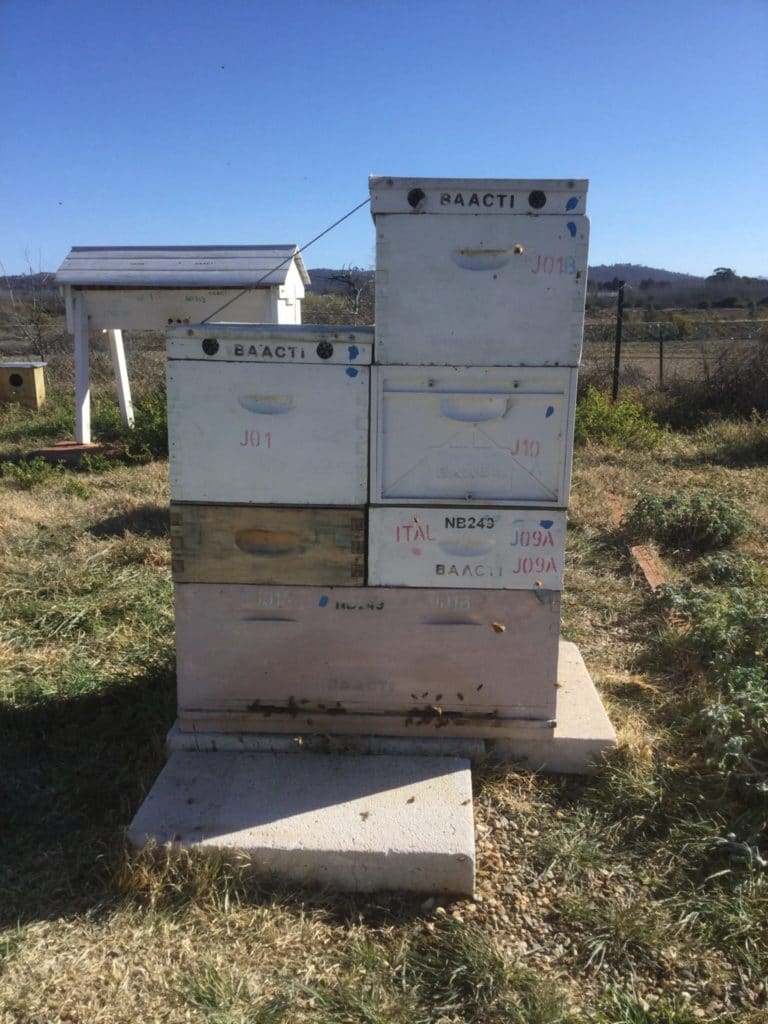
Figure 6 Sixteen-frame brood box with central vertical queen excluder – not shown – and horizontal queen excluders tiered up with honey supers, summer 2019-2020. Photo: Alan Wade
Elsewhere we have been experimenting with a 64-frame horizontal Langstroth hive (Figure 7). This accommodates separate queens, one on each wing, common honey frames being located between the two brood nests. The hive was well-insulated hive doing well in a drought year: 38 kg of honey was harvested from the two-queen colony that started as small nucs at the beginning of the 2019/2020 season. By comparison 175 kg of honey was taken from four conventional two-queen and doubled hives in the same period. We are still learning how to best utilise these hives but they are more productive than single-queen colonies.
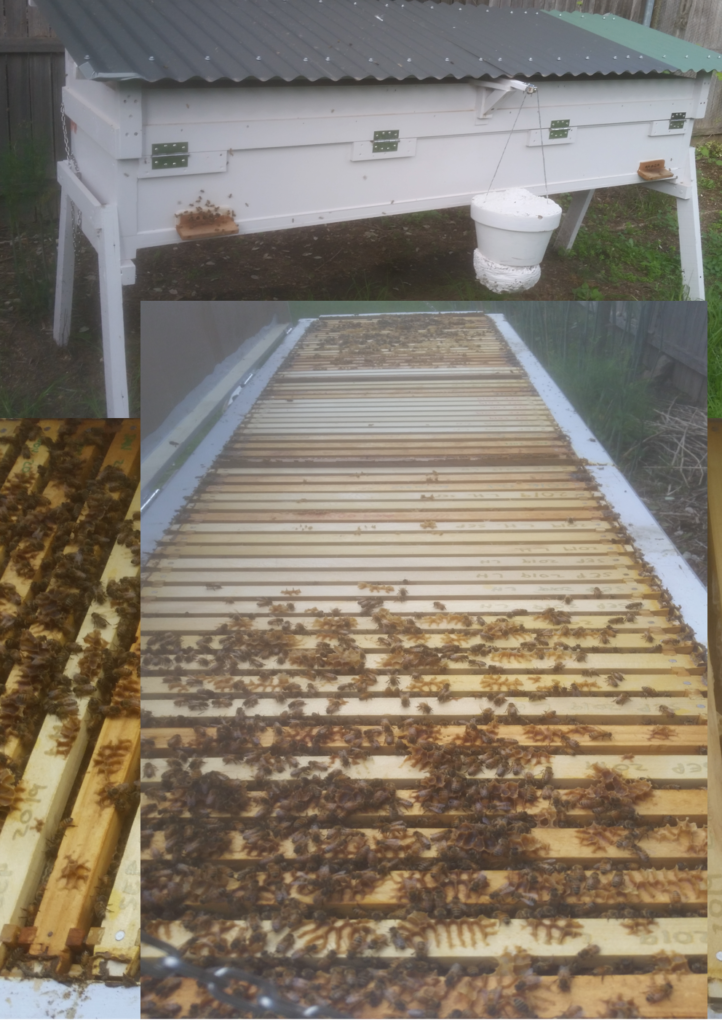
Figure 7 Derwent horizontal hive with sixty four frames, two queens and two queen excluders. Photos: Frank Derwent.
An interesting facet of 1890’s horizontal hive was their wide use in doubled queened hives comprising a jumbo twenty frame full-depth Langstroth brood chamber*, partitioned by a thin reinforced board precision drilled 3 mm holes at 25 mm intervals – the so-called Wells Dummy. This allowed side-by-side colonies to share brood nest warmth and exchange of colony pheromones. In early spring the hives were united and supered over a large excluder using twenty frame shallow honey supers that could either be used to produce extracted comb or section comb honey. At seasons’ end the powerful double queen hive was simply returned to well-provisioned side-by-side single-queen hives where the central division board allowed shared warmth and better overwintering capacity than standalone single hives.
*Wells employed a fourteen frame brood-chamber, but added shallow supers to allow each queen to lay to her full capacity.
Hive homeostasis and hive architecture
The brood nest of honey bee is a remarkable entity. Its role in raising large numbers of bees quickly – laid egg to emerging bee in twenty one days – is dependent on optimal hive nutrition, controlled temperature inside the working hive and the elevated temperature of the actual brood nest. While sealed brood can be warmed by heater beesxiv, the nest as a whole is regulated at 35 ± 0.5 0C by clustering or fanning bees, a thermal condition common to the whole Apis genus. For example the Giant Honey Bee, Apis dorsata xv orients its large single comb to minimise the impact of wind and rain while the brood itself is warmed by a curtain of bees (at the same 35 0C). Tan and coworkers found that cavity dwelling Asian Honey Bee, Apis cerana, operates its brood nest at a slightly lower temperaturexvi.
Insulation: Mitchellxvii has investigated the value of year round hive insulation, pointedly noting that wild hives tend to be far better protected than even the most heavily insulated man made hives. But insulation – installed primarily to minimise stores consumption – is only a small part of the equation. Mitchell calculated that bees consume between 25 and 50% of the nectar delivered to the hive in transforming it to storable honey. Well-insulated hives improves not only colony productivity but also results in much less wing wear extending bee longevity.
The full benefits of improved insulation extend to effective regulation of the colony water budget, fewer water gatherers, less condensation on hive walls, earlier bee flight on chilly mornings and less bearding of bees at hive entrances on summer evenings. Further, better regulation of the internal hive environment results in lower incidence of stress diseases such as nosema, European Foul Brood and chalk brood.
Ventilation: Somerville and Collinsxviii examined the impact of screened bottom boards on hive ventilation. The role of screened flooring in removing insect fras, comb debris and chalkbrood mummies means that spring cleaning of hive bottom boards has become a thing of the past. Screened bottom boards have also reduced mould problems and removed the breeding ground for small hive beetle and lesser wax moth. Nevertheless sheltering bees from wind and away from wet areas are sensible if not hive architecture maxims.
Hive materials: It is difficult to express any preference for construction materials beyond stating that insulated gear, built in or added, greatly improves colony performance. All hives deteriorate over time and normally either rot or deteriorate in sunlight (some plastics are photo stable). Some are readily fractured if dropped and several are easily punctured or subject to wax moth and rodent attack. Most, though not plastic, hives require regular painting or treatment (we have copper naphthenated wooden hives that have survived for forty years). Our best advice is to repair hives promptly or retire gear that lets in the weather or that weakens hive defence.
Hive frames: We also have some preference for wax over plastic foundation though clip-in plastic foundation is quick to install but must drawn on a honey flow in, or just above, the brood nest. Undrawn plastic comb, like warped or regular wax foundation and combs with large gaps, equates to unused real estate. These hive dead spots can’t store honey and pollen and can’t be used to raise brood.
We also have a strong preference for wood over plastic frames, though the latter appear immune to wax moth attack. Most plastic frames have notches and crannies that fill with wax and propolis and are nearly impossible to clean. Further they curl up in hot water and in solar wax melters. Plastic gear, touch wood, is made of plastic.
So what is the best hive?
This we cannot say, well not with any certainty. As to the hive choices we have made, we would both have acquired different gear to that we now own, and would have kept bees in a different way, had we now known what we now know.
What we do know, however, is that wild bees normally select a snug home and would appear to have a strong preference for a hive architecture that reflects a fairly roomy vertical hollow rather than a spread out McMansion.
iSeeley,
T.D. and Morse, R.A. (1976). The nest of the honey bee (Apis
mellifera
L.). lnsectes
Sociaux
23(4):495-512.
Morse,
R., Layne, J.M., Vissher, J.K. and Ratneiks, F. (1993). Selection
of nest cavity volume and entrance size by honey bees in Florida.
Biological
Sciences
56(3):163-167.
iiCrane, E. (1999). The world history of beekeeping and honey hunting. Routledge, New York.
iiiSeeley, T.D. (2019). The lives of bees: The untold storey of the honey bee in the wild. Princeton University Press. Chapter 11, Darwinian Beekeeping, pp.277-292.
ivWell made kits currently retail at around $450 or $800 fully assembled.
vHorr, B.Z. (1998). My intensive two-queen management system means bigger crops. American Bee Journal 138(7):507-510.
viDugat,
M. (1948). The skyscraper hive. Authorized translation of La Ruche
Gratteciel à Plusiers Reines by Norman C. Reeves. Faber and Faber,
24 Russell Square, London.
https://www.abebooks.com/servlet/SearchResults?an=dugat+father&bi=h&ds=5&n=100121503&sortby=1&tn=skyscraper+hive&cm_sp=mbc-_-ats-_-filter
Butler,
C.G. (17 July 1948). The skyscraper hive. Nature
162(4107):87.
viiWarré, É (1948). L’Apiculture Pour Tous (12th edition). Translated as Beekeeping for All by Patricia and David Heaf, January 2007, Lightening Source, UK. http://annemariemaes.net/wp-content/uploads/2013/10/beekeeping_for_all.pdf Note: Canberra Region Beekeepers has a copy of English version in its library.
viiiA standard eight frame langstroth super has internal dimensions of 240 mm (deep) x 470 mm by 375 mm (42.3 L) with clearance below bottom brood box of 4 L.
ixUnited
States Patent Office (1912). Lorenzo L. Langstroth, of
Philadelphia, Pennsylvania. Beehive. Specification forming part of
Letters Patent No. 9,800, dated October 5, 1852; Reissued May 26,
1863, No. 1,484, 10 pp.
https://patents.google.com/patent/US9300?Oq=beehive+honey+langstroth
Langstroth,
L.L. (1853). Langstroth
on the hive and the honey-bee: A beekeepers manual.
Hopkins, Bridgman & Company, Northhampton, Advertisement
: L L. Langstroth’s movable comb hive. Patented October 5, 1862, pp.9-10. http://www.hunter-valley-amateur-beekeepers.org/hvaba_link_documents/langstroth%20-%20the%20hive%20and%20the%20honey%20bee.pdf
xHuber, F. (1806). New observations on the natural history of bees, Volume 1. Letters written by François Huber between 1787 and 1791. http://www.bushfarms.com/huber.htm
https://books.google.com.au/books?id=jXdlJ&printsec=frontcover&dq=huber+leaf+hive+photo&hl=en&sa=X&ved=0ahUKEwiMsvTInvniAhUCfSsKHZ_aDIAQ6AEIMzAC#v=onepage&q&f=false
xiDzierżoń, J. (1882). Dzierzon’s rational beekeeping or The theory and the practice of Dr Dzierzon. Translated by Dirk and Stutterd, Houlston & Sons, Paternoster Square, Southall: Abbott, Bros. https://ia800201.us.archive.org/17/items/dzierzonsration00stutgoog/dzierzonsration00stutgoog.pdf and http://reader.library.cornell.edu/docviewer/digital?id=hivebees5017629#page/5/mode/1up
xiiLangstroth, L.L. (1857). Langstroth on the hive and the honey-bee: A beekeepers manual. C.M. Saxton & Co., Agricultural Booksellers – 40 Fulton Street, New York. in Chapter VII On the advantages which ought to be found in an improved hive, pp. 98-113. http://www.southeastalabamabeekeepers.com/files/A_Practical_Treatise_on_the_Hive_and_Honey_Bee.pdf
xiiiSimpson, J. (1958). The problem of swarming in beekeeping practice. Bee World 39(8):193-202. https://doi.org/10.1080/0005772x.1958.11095063
xivKleinhenz, M., Bujok, B., Fuchs, S. and Tautz, J. (2003). Hot bees in empty broodnest cells: Heating from within. Journal of Experimental Biology 206(Pt 23):4217-4231. Dec 2003 DOI : 10.1242/jib.00680 https://www.researchgate.net/publication/9037048_Hot_bees_in_empty_broodnest_cells_heating_from_within
xvKastberger, G., Waddoup, D., Weihmann, F. and Hoetz, T. (2016). Evidence for ventilation through collective respiratory movements in giant honeybee (Apis dorsata) nests. PLoS One. 2016; 11(8): e0157882. doi: 10.1371/journal.pone.0157882
xviTan, K., Yang, S., Wang, Z-W., Radloff, S. and Oldroyd, B. (2012). Differences in foraging and broodnest temperature in the honey bees Apis cerana and A. mellifera. Apidologie 43(6):618-623. https://www.tib.eu/en/search/id/BLSE%3ARN321836196/Differences-in-foraging-and-broodnest-temperature/
xviiMitchell,
D. (2016). Ratios of colony mass to thermal conductance of tree and
man-made nest enclosures of Apis
mellifera:
Implications for survival, clustering, humidity regulation and
Varroa
destructor.
International
Journal of Biometereology
60:629-638.
DOI
10.1007/s00484-015-1057-z
https://www.ncbi.nlm.nih.gov/pubmed/26335295
https://docs.google.com/viewer?a=v&pid=forums&srcid=MTQ1OTYwMzIwNzQ2NzIzNDE4MDcBMDc3NDA4MjkyOTA0MTMzNTYzMDUBUjE0WWxzVU9BZ0FKATAuMS4xAQF2Mg
Mitchell,
D. (2019). Thermal efficiency extends distance and variety for
honey bee foragers: Analysis of the energetics of nectar collection
and desiccation by Apis
mellifera. Journal
of the Royal Society Interface,
26pp. https://royalsocietypublishing.org/doi/10.1098/rsif.2018.0879
http://eprints.whiterose.ac.uk/141143/3/rsoc23122018-manuscriptD.pdf
Stabentheiner,
A., Kovac, H. and Brodschneider, R. (2010). Honeybee colony
thermoregulation: Regulatory mechanisms and contribution of
individuals in dependence on age, location and thermal stress PLoS
One
5(1):e8967.
doi: 10.1371/journal.pone.0008967
https://www.ncbi.nlm.nih.gov/pmc/articles/PMC2813292/
xviiiSomerville, D. and Collins, D. (2014). Screened bottom boards. Rural Industries Research and Development Corporation. RIRDC Publication No 14/061, 47pp. RIRDC Project No PRJ-006390 https://www.agrifutures.com.au/wp-content/uploads/publications/14-061.pdf

Be the first to comment